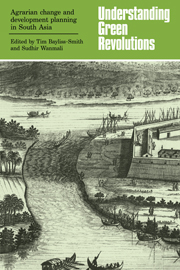Book contents
- Frontmatter
- Contents
- List of contributors
- Preface
- I Understanding Green Revolutions: an overview
- II Agrarian change at village level
- 5 Agrarian policy and agrarian change in tribal India
- 6 Migration and agrarian change in Garhwal District, Uttar Pradesh
- 7 Agricultural development in Tamil Nadu: two decades of land use change at village level
- 8 Energy flows and agrarian change in Karnataka: the Green Revolution at micro-scale
- 9 Income and wealth disparities in a land settlement of the Sri Lanka Dry Zone
- 10 Agrarian structure and agricultural innovation in Bangladesh: Panimara village, Dhaka district
- 11 A structural analysis of two farms in Bangladesh
- III Development planning and agrarian change
- Index
9 - Income and wealth disparities in a land settlement of the Sri Lanka Dry Zone
Published online by Cambridge University Press: 25 May 2010
- Frontmatter
- Contents
- List of contributors
- Preface
- I Understanding Green Revolutions: an overview
- II Agrarian change at village level
- 5 Agrarian policy and agrarian change in tribal India
- 6 Migration and agrarian change in Garhwal District, Uttar Pradesh
- 7 Agricultural development in Tamil Nadu: two decades of land use change at village level
- 8 Energy flows and agrarian change in Karnataka: the Green Revolution at micro-scale
- 9 Income and wealth disparities in a land settlement of the Sri Lanka Dry Zone
- 10 Agrarian structure and agricultural innovation in Bangladesh: Panimara village, Dhaka district
- 11 A structural analysis of two farms in Bangladesh
- III Development planning and agrarian change
- Index
Summary
The physical environment of the Dry Zone of Sri Lanka, with its fluctuations and variability of the rainfall regime, high potential evapotranspiration, relatively low water-holding capacity of the soil, and rapid release of soil moisture at low tensions, have imposed prohibitive limitations on the availability of water to crops (Farmer, 1956; Rasiah, 1980). Hence the provision of irrigated water becomes an essential prerequisite in the establishment of a viable agrarian economy within the area.
When the British took over the island in the nineteenth century the Dry Zone, which was the seat of the ancient kings (fifth century B.C. to thirteenth century A.D.), had long since been abandoned, and the region was jungle clad, rife with malaria, and scantily populated, and the man-made reservoirs which were built to provide water for paddy cultivation were damaged (see Farmer, 1957, pp. 8–18).
A typical settlement of the Dry Zone in this period was described in these terms: ‘Here the air is heavy and unwholesome, vegetation is rank, malaria broods over the waters as they escape from the broken tanks …’ (Tennent, 1860, p. 611). Yet today this region is recognized as most attractive to internal migrants (ESCAP, 1976, p. 56), a transformation which testifies to the success of half a century of measures for regional development. The eradication of malaria in the 1940s contributed in no small measure to this success, but colonization schemes have been the major tool for state intervention.
- Type
- Chapter
- Information
- Understanding Green RevolutionsAgrarian Change and Development Planning in South Asia, pp. 173 - 193Publisher: Cambridge University PressPrint publication year: 1984

